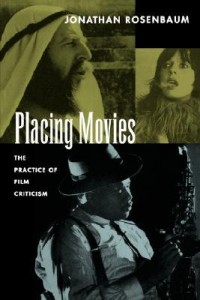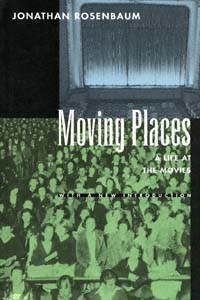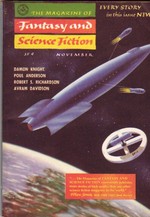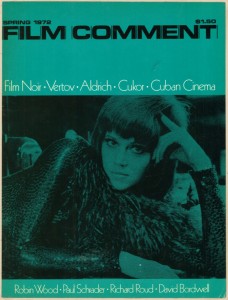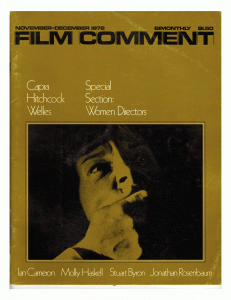The main introduction to my first collection, Placing Movies: The Practice of Film Criticism (University of California Press, 1995). My apologies for not updating the links. — J.R.
This book is intended as a companion and sequel to an autobiographical experiment I carried out in the late 1970s, published in 1980 by Harper & Row as Moving Places: A Life at the Movies. The present volume doesn’t require a reading of that earlier book — long out of print, though recently reprinted by the University of California Press so as to reappear alongside this collection; however, since many of this volume’s premises are predicated on either extensions or inversions of the premises of its predecessor, a few words about that book and the material it covers are in order.
Most of Moving Places is concerned with my childhood in northwestern Alabama, specifically in relation to my family and what was known as the family business from around 1914 to 1960. This business began when my grandfather, Louis Rosenbaum, started operating his first movie theater in Douglas, Wyoming, and it existed until Rosenbaum Theaters, owned by my grandfather and managed by my father, was sold to a larger chain. I was born in 1943, and the family business afforded me a steady diet of free movies through the age of sixteen, when I went away to school in Vermont. As a consequence of this perk, I saw practically every feature that had national distribution between the late 1940s and the autumn of 1959.
The focus of Moving Places — written after I had been working professionally as a film critic for several years — included all the circumstantial, personal, historical, and ideological aspects of experiencing movies that criticism generally factors out. The project had personal urgency for me because I wanted to forge links between two mainly disconnected portions of my life — my childhood in Alabama, and my career as a critic in New York, Paris, London, and San Diego. My initial points of entry were movies with no critical standing of any kind — principally BIRD OF PARADISE and ON MOONLIGHT BAY — that I had not seen since the early 1950s. Seeing them again on television in 1977 and 1978, I was interested in discovering first what they told me about myself as a child (through Proustian recollections of my initial responses), and then what these findings told me about movies in general. Later, this material was supplemented by detailed and obsessive research — much of it conducted in Florence, my hometown — about the history of what I had seen (and when, and under what circumstances), and, beyond that, the history of the family theater chain.
I had written a great deal as a child, but until the late 1960s my writing had basically consisted of fiction and poetry, not criticism. (In fact, I was working on the first of my three unpublished novels when the theaters were sold during my senior year in boarding school, and the other two novels were written over the next decade.) Part of the synthesis I was pursuing in Moving Places had to do with this discontinuity as well: as a writing project it was literary and personal/historical rather than critical in any conventional sense, and I naively hoped at the time that such a book could pave my way out of film criticism and into a literary career. Unfortunately, apart from a few reviews (mainly in newspapers west of the Hudson and film magazines), it was regarded exclusively as a film book — it had no impact at all on the literary world — and not as a kind of film book with any status in relation to sociology, social history, film history, or film exhibition. (To the best of my knowledge, it has never appeared in bibliographies related to any of these subjects — or to “cultural studies,” for that matter.) It did achieve some genuine success and longevity as a cult item, but basically among film buffs, and not of the sort that could be parlayed into any sort of career opportunities, journalistic or academic. To make a living — both during and after the writing of the book — I had to return to whatever freelance work I could find, which proved to be journalism, criticism, and teaching.
At the same time, I should stress that writing Moving Places permanently altered some of my positions as a film critic, which is another reason why it seems necessary to define that book as a watershed in my evolution. It taught me that subjectivity in critical writing is never something to be avoided — to try to do so is merely to make one’s self the passive victim of its complex operations — but always something to be defined and accounted for. It also taught me, as a corollary to this, that where and when one is viewing a movie has an inextricable relation to what that movie means, and that consequently no meanings should ever be regarded as universal or eternal. To put it more simply, it forced me to recognize that moviegoing — and therefore film criticism — is a social act.
***
I offer this account to set the stage for this volume, which presents an autobiographical placement of my film criticism, designed for both serious moviegoers and for those people among that group who are considering serious film criticism as a profession. The critical pieces I’ve selected are thus intended to serve double duty, functioning both as essays and reviews in their own right and as particular cases (or case histories) that point to some of their sources, circumstances, and functions.
One part of my aim coincides with the project of Moving Places almost identically — to objectify my own positions in the autobiographical segments that follow rather than set myself up as some sort of hero or role model. Although I have obvious biases as a critic which will become increasingly clear as the book develops — and do my utmost to argue on their behalf, though I also try to contextualize and place these positions so that readers will know as much as possible where they’re coming from — it is not my intention to advise or instruct potential critics in how to duplicate my own tastes and procedures. As in Moving Places, I can best be regarded as a test case, and with this in mind, I have done my best to draw attention to some of my own critical shortcomings — insofar as I’m aware of them — and encourage readers to draw their own conclusions about them. Although a central part of my concern is to provide a guided tour through film criticism as a profession — one intersecting and interacting with editors, readers, publicists, fans, and filmmakers alike — I think it would be more useful for readers to regard me as a vehicle in this enterprise than for them to regard me as a definitive tour guide, much less as an ultimate destination. (As Godard usefully put it in an interview I once had with him, “I’d like to regard myself as an airplane, not an airport.”)
***
One of the consequences that writing Moving Places had on some of my earliest film memories was to paralyze and then evacuate them — which means that if I want to trace certain facts or strands relating to my prehistory as a film critic, I’m often better off referring to the book than to my own recollections. This book tells me, among other things, that two of my first pieces of sustained film criticism were written during my teens — at the ages of fourteen and nineteen, respectively. Together, they form a dialectic of sorts which defines what film criticism has personally meant for me ever since.
The first piece was a guest column written for the Florence Times, “reviewing” the major releases that Rosenbaum Theaters were showing that week. Every other week, this column was written by my father, and my frequent criticisms of his efforts led to him inviting me to take over the job on a one-shot basis. Like him in most cases, I hadn’t seen most of the movies, but the fact that I’d already seen the Disney cartoon accompanying FANTASIA out of town a few months earlier — an Oscar-winning CinemaScope effort called TOOT, WHISTLE, PLUNK AND BOOM — gave my plug the status of a genuine testimonial. (“Frankly, it’s the best cartoon I’ve ever seen.”) I’m sure that if anyone had asked me at the time, I would have considered such a statement of in-house promotion film criticism, and a sincere form of it at that.
My second opus, never published, was a brief essay arguing on behalf of the moral and aesthetic superiority of FOLLOW THAT DREAM, a flaky and somewhat pro-anarchist Elvis Presley comedy, over SWEET BIRD OF YOUTH, a Richard Brooks desecration of a Tennessee Williams play I had previously seen on stage and loved in that form. The piece was written about a year and a half after Rosenbaum Theaters had been sold, shortly after I had gone to see the movie with my grandfather at the largest of the theaters he had built. The fact that he had howled with pleasure at some of the movie’s crudest jokes goaded me into some sort of rebellious self-definition, which was undoubtedly a major source of the piece.
Two years after that came one of my first serious published efforts — an extended, troubled review of Kubrick’s DR. STRANGELOVE for the Bard Observer, my college newspaper, that attempted to square the film’s virulent misanthropy with its comedy. The piece concluded: “Basically, I believe that the movie is hateful as far as it is successful, and unsuccessful insofar as it is likeable; for its success depends on the strength of its vision and its ability to convince us, and I doubt seriously whether any of us [is] un-man enough to take it. As an experience, however, none of us is likely to forget it.” The review prompted an unsolicited favorable comment from the best teacher I ever had — Heinrich Blücher, the husband of Hannah Arendt and Bard’s presiding philosophical guru — and, come to think of it, its dialectical play undoubtedly bore the mark of his Hegelian influence. But another reason why I’m recalling this early review is to point to a concrete example of how the cast of a particular period can inflect and even determine a movie’s meaning. A week or so before, when I’d gone to see the movie near Times Square with some of my best friends, one of them — Kathy Stein, who sixteen years later became my editor at Omni — emerged from the shock of that experience devastated and in tears. For her, seeing the end of the world as comic was not only frightening but morally hateful, and her passionate response made a permanent impression on me. The unlikelihood of anyone of college age having that sort of reaction to DR. STRANGELOVE today tells us something important, I suspect, about what’s happened to our sensibilities since then — not only in relation to the idea of nuclear holocaust, but also in relation to comedy. I think it’s possible that we’ve lost something.
***
Although I had achieved a modicum of literary success during my early teens — one poem won first prize in a national contest, and I sold a vignette to Anthony Boucher’s The Magazine of Fantasy & Science Fiction in 1956 that was eventually published in English, Spanish, and Japanese — none of my subsequent fiction was published outside of school and college literary magazines, and even the fact that I was writing occasional film and literary reviews for student newspapers and running a film series at Bard didn’t suggest to me that I would eventually be doing this sort of work for a living. After spending five years as an undergraduate English major at Washington Square College (1961–1962) and Bard College (1962–1966), most of them enjoyable — it was at Bard that I had close friends, and likewise felt I was a respected member of an intellectual community, for the first time in my life — I wound up wasting two and a half years as a graduate student in English at the State University of New York at Stony Brook (1966–1968). Although the hefty number of military enlistments in Alabama kept me safe from the draft after 1968, the possibility of getting drafted prior to that kept me enrolled in a program I had little respect for, vaguely motivated by the assumption that I would wind up teaching English and American literature for a living. Even then, I was enough of a film buff to propose doing a dissertation involving film and literature, but when I quit Stony Brook about a year later, I still hadn’t succeeded in getting any sort of support from the faculty.
In retrospect, I consider myself highly fortunate that the option of becoming a graduate student in film study was not open to me at the time, because I might well have taken it. The reason why I “broke into” film criticism professionally was equally circumstantial: an acquaintance who was starting a series of monographs and books on film directors, with the aim of selling the whole package to a publisher, hired me to edit a collection of pieces on major directors — an anthology that he or we dubbed Film Masters — at the same time that I was looking for a good excuse to quit graduate school. (Another excuse was my third novel, which I had already started writing. But Film Masters provided the additional inducement of a modest income to supplement my inheritance from my grandfather, which was my main means of support — an alternative, in other words, to my salary for teaching freshman English at Stony Brook.) A further incentive was that I was provided with a budget to commission translations from the French, and I was finding the research involved in the project — the screenings as well as the readings — a lot more exciting than the enforced and pedantic labors of graduate school.
By the time Film Masters was sold to Grosset and Dunlap, I believe I had already decided to move from Greenwich Village to Paris, which I wound up doing in the fall of 1969. By that time, I had written my first “serious” extended piece of film criticism — an essay about my favorite film at the time, SUNRISE. For this piece, I had made special research trips to the George Eastman House in Rochester and the Cinémathèque Royale de Belgique in Brussels to look at other films by F. W. Murnau and had paid for a special screening of TABU at the Museum of Modern Art. (Stephen Koch, a friend from Stony Brook, had brought along Annette Michelson to the screening, and it was the first time we met. She went on to become a good friend and strong influence and for a brief period was interested in getting Film Masters published at Praeger — until my employer opted for bigger bucks by going with Grosset and Dunlap. Things started to unwind between us around 1977, the time that “Regrouping” was published, which Annette scornfully told me might have been written by Penelope Gilliatt.) I had also spent a highly enjoyable summer in Paris and London pursuing my research and meeting various contributors to the book while working on my third novel.
Professionally speaking, however, all these activities ended in grief. If painful memory serves, Film Masters twice made it into galleys at Grosset and Dunlap before being yanked from production by editors who had second thoughts on the project. (It’s possible that they were wrong. I would estimate now that the book was a few years ahead of its time in some of its selections and emphases, though hardly as earthshaking as I then believed; within a few years, many of the pieces I had selected for translation or commissioned wound up in print elsewhere.) The man who had hired me to edit the book — a Scientologist in that period who had disappeared with the book’s illustrations when he flew to the west coast with Grosset and Dunlap’s advance in order to finance further “auditing” — was not to be heard from again for years, so the book no longer had an agent to defend or promote it. Even after I flew back to New York, hired a lawyer, recovered the stills, and acquired some legal protection, I still couldn’t convince anyone to publish the book in any form, and having by this time moved all my belongings to Paris, I was ill-prepared to shop it around. Nor did my novel, when I finally finished it, fare any better. I still had the dregs of my inheritance to keep me going in Paris, as well as a passionate interest in movies that my ambitious work on Film Masters and my subsequent move to Paris had only intensified.
So it seemed only natural, during one of my trips back to New York, to ask the staff — specifically Richard Corliss, the editor, and his assistant, Melinda Ward — of a recently refurbished film magazine there called Film Comment if they could use a Paris correspondent. The reply was an invitation to send them a sample piece, which I did, and which ran in their Fall 1971 issue, two years after my move to Paris. From then on, I resolved to write something for every issue, even after they went from quarterly to bimonthly, and was delighted to discover that they printed everything I wrote for them. It wasn’t a living, to be sure, but it was a beginning; and after my name appeared on the cover of the November–December 1972 issue — occasioned by a piece on Orson Welles’s first Hollywood project, HEART OF DARKNESS, which had entailed an interview with Welles in Paris — even my grandmother, who had denounced me for wasting my life a year or so before, was duly impressed.
Earlier in 1971, with the encouragement of Andrew Sarris — whom I had met in connection with the ill-fated Film Masters — I began writing occasional pieces for the Village Voice, starting with a pedestrian account of having been an extra on Robert Bresson’s FOUR NIGHTS OF A DREAMER (29 April) and moving on from there to Cannes Film Festival coverage (1971 and 1972), occasional reviews during visits back to New York (GLEN AND RANDA in 1971, REMINISCENCES OF A JOURNEY TO LITHUANIA and MOONWALK ONE in 1972), and then book reviews — Thomas Pynchon’s Gravity’s Rainbow, Noël Burch’s Theory of Film Practice, Dwight Macdonald’s Discriminations, Gore Vidal’s Myron, and, many years later, Jerry Lewis in Person and Martin Gardner’s Science: Good, Bad and Bogus.
I have gone to the trouble of recounting this minihistory in spite of my decision to omit all my (mainly less than durable) Voice pieces from this collection because I have to confess that the personal-confessional and vernacular mode associated with the Voice had an enormous effect on my writing for other magazines — specially my “Journals” for Film Comment, but also a few of my Sight and Sound articles as well (see, especially, the Edinburgh piece). The gonzo journalistic mode associated nowadays with Tom Wolfe and Hunter S. Thompson — neither of whom, I should add, ever impressed me as much as their reputations seemed to warrant — surely had some of its roots in the nonfiction of Norman Mailer, who wrote a column for the Voice in the 1950s and who influenced my prose a lot more.
I don’t mean to imply by this association, however, that the macho branch of autobiographical writing in the Voice — a tradition sustained today by J. Hoberman — was the only kind that affected me. Undoubtedly even more influential was the passionately sincere and hypersensitive critical writing of James Stoller, a Voice proofreader in the 1960s and 1970s who launched a wonderful (albeit short-lived) magazine called Moviegoer with Roger Greenspun when I was still an undergraduate, and who wrote a Voice column for a time called “16mm.” (Eventually, I’m sorry to say, Stoller gave up writing and transferred his love of film to opera; he still works as a proofreader, but not for the Voice. And Roger has remained a friend for almost thirty years.) Still another important influence at this time was Susan Sontag, whom I’d been instrumental in inviting up to Bard for a talk during the same period — soon after her notorious “Notes on Camp” was published in Partisan Review (and her essay on Godard’s VIVRE SA VIE appeared in the second issue of Moviegoer), but prior to the publication of “On Style,” which is what she read that evening. I was running the Friday night film series at the time and had been getting some flak from fellow students for showing such movies as THE LADY FROM SHANGHAI, UNDERWORLD, TRIUMPH OF THE WILL, and SUNRISE. The fact that Susan cited the first three films with some approval in her essay, and later told me that she had burst into tears when she’d first seen SUNRISE, won me over to her heart and soul that evening.
***
A few words on some of the principles of selection I’ve followed in this collection. Automatically eliminated are capsule reviews, book reviews, annual ten-best list columns, production stories, interviews, film festival reports, and all of my pieces that have been reprinted in other books. (These latter omissions, as well as all the other major film pieces of mine that have been excluded for one reason or another, are listed in the bibliography, in order of their original publication.) Including my capsule reviews, I estimate I’ve published over twenty-six hundred pieces in sixty magazines and newspapers; this selection comprises thirty-one, drawn from seven publications.
I’ve tried to strike a balance between pieces included for their critical value and those that are included because of the importance of the films and filmmakers I’m writing about — often being guided, in the latter case, by works and figures that I believe have been unjustly neglected elsewhere. This means that a certain number of pieces deal with films that are either difficult to come by in the United States or completely unavailable. Although the customary approach in collections of this kind is to avoid at all costs writing about films that can’t be seen, I strongly object to this practice as a means of passively promoting — by continuing — a vicious circle. Most uncommercial (or “uncommercial”) films of value only get shown if critics clamor loud and long enough to stir up some interest in them; this is what I’ve been trying to do for virtually my entire career as a critic, and it would betray the thrust and meaning of that work if I avoided that policy here.
— September 1993

